I installed my Canyon City Tire Carrier w/ Jerry Can Mounts (here after know simply as the “rack”) in December of 1999. I had been wanting to be able to carry extra gas (the stock tire carrier was fine for the spare tire) for some time. I did as much research as possible and got some input from a few folks. I considered a couple racks that bolted to the TJ’s rear door but was not impressed with what they offered. One rack was not specifically designed for jerry cans, but you could put them in the rack section. It did state that there was a 75 lb. max load capacity and that two cans would be 80+ lbs. That one fell by the way side.
I found another rack that also mounted to the rear door and claimed that one a jerry can on either side of the rack, leaving the top open for more gear. Its design did not vary much from the first one and I could not figure out what was giving it the extra load capacity. I sent the manufacturer e-mail and requested further info. After a week and no answer, this rack was also dropped as a candidate.
I finally decided on the Canyon City made rack. Its main selling point for me was the heavily reinforced mounting setup. The manufacturer supplies 10 gauge reinforcing brackets that bolt to the inside of your Jeep and support the body areas where the rack attaches. As far as attachment goes, it “borrows” the existing rear door hinges on the passenger side and you mount a new latching mechanism on the driver side of the rear door.
Before I get into the install comments, let me say that I am satisfied with the final product. However, getting it installed was much harder than it needed to be.
The Instructions:
The instructions that came with my TJ rack kit were poor at best. It was a cobbled together set of pages that dated back to 1992. The actual steps covered a mere double sided page. The other pages were a collection of CJ and YJ drawings which were obviously a BIG help in my TJ installation (note that the front page specifically said this was for the TJ kit). The other thing I found quite amusing was the disclaimer that stated that the rack was NOT intended to carry flammable liquids. Their website shows RED jerry cans in the picture. I guess they put water in the RED cans so thirsty people can locate the cans quickly? Come on Canyon City, who are you trying to kid here?
The other problem was that you were often times referred to “the picture”. As I said, there were no TJ pictures, or any other picture that contained anything about what that step was detailing.
Some of the steps were out of sequence. For instance, the instructions told you to remove the hinge pins from the rear door, and then remove the door from the TJ. With only 4″ of space between the bottom of the lower hinge pin and the bumper, I found it impossible to somehow get a drift punch and a hammer into that 4″ space an drive out the pin. I suppose it is possible, but considering that I finally resorted to a hydraulic press to remove mine, I don’t think it was possible as stated. Perhaps on an older YJ, this might have been possible. Considering the age of this document, I would guess this might have been the case.
The Rack:
The rack comes assembled, for the most part. There are two body reinforcing plates, the striker plate, and an assortment of nuts, bolts, etc. One nice touch was the 3 lug nuts that Canyon City included. Unfortunately, they are not the same size as the factory 3/4″ lug nuts so you either need a universal lug wrench or you figure out another plan. My plan was not to use them, however, they came in very handy near the end of the installation. (more on that later)
The reinforcing plate that mounted on the left side (where the striker plate is attached) was too big to fit. A portion of it sat on top of the roll bar mounting flange, causing the plate to not fit up against the body squarely. A session with the hacksaw and a follow-up visit to the grinder took care of that problem. Again, this was something that should have been caught at the factory. Perhaps this plate was designed for one of the older models and never properly redesigned for the TJ?
Another major problem was the wheel mounting studs. Canyon City welds a nut over a hole on the wheel mounting plate. Taking the three supplied studs, you thread them into the holes of your choice, either 5 on 5.5″ or 5 on 4.5″ holes. After I had mounted the rack and threaded the studs into the 4.5″ patterned holes, I discovered that the wheel did NOT fit properly onto the studs. Two of the studs were slightly off. My final solution was to screw the previously discarded lug nuts (remember the ones that didn’t match?) onto the studs. With the help of a 3 lb. hammer, I beat the lug nuts (they sacrificed themselves to protect the threads) repeatedly until the studs were “fine tuned” into the proper position. Now I know why they have those big reinforcing plates in there….wanging on those studs with a big hammer puts quite a bit of torque on that rack! After the studs were checked a couple of times for the proper fit, the lug nuts were permanently discarded as some of the flats were starting to take on a different geometry!
Photos:
Here are a few shots of the rack taken during the installation.
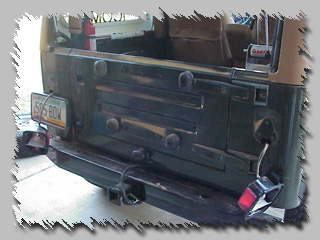
The factory spare tire carrier and 3rd brake light have been removed. Since there is no provision to recycle the brake light on the new rack, I removed the electrical connector that is screwed onto the inside of the rear door where the brake light wiring enters the door.
I still need to de-energize (remove the power) from the contacts that remain on the passenger fender well. With the rear door contacts removed, these contacts are not exposed and will be energized when ever the brakes are applied. Any metallic object that touches both of these contacts will blow a fuse when the brakes are applied.
It also works much easier if you remove the tail lights (just the mounts, not the wiring) and let them drape down out of the way.
I have not removed the rubber tire bumpers from the rear door yet, but will be doing so shortly.
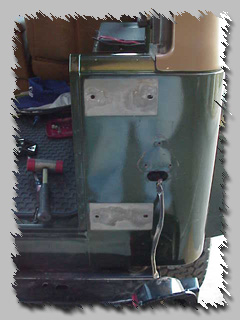
I found it necessary to remove the four TORX bolts (#40) that held the door hinges to the body before I could get the hinge pins out.
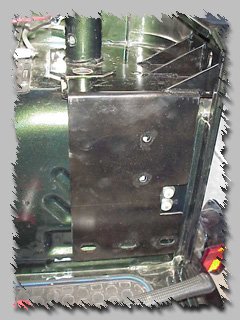
After removing the two TORX bolts holding the roll bar in place, you can slide the reinforcing plate under the roll bar and snug the plate up against the rear of the body. I found a rubber mallet was handy for coaxing the plate into position.
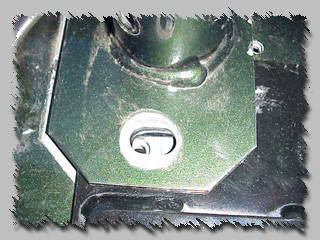
A close-up shot of the roll bar mounting point. It lines up fairly good. I wish the Canyon City plate was a bit larger so the roll bar sat evenly on the new reinforcing plate.
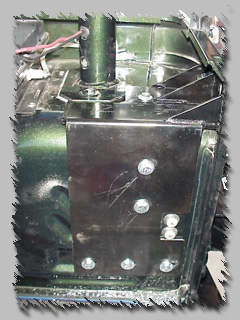
You will drill 5 holes on the side and 1 hole on the top of the plate. You will also need to drill the holes for the upper hinge bolts. The instructions don’t mention that these bolts are larger than the factory bolts. That means you also will have to enlarge the holes in the upper hinge too.
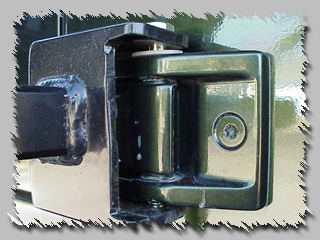
As you can see, the fit on my upper hinge is not exactly “tight”. The new hinge bolt is in place and snugged down. There is a fairly big gap, where the nylon washer is, between the top of the factory hinge and the rack hinge.
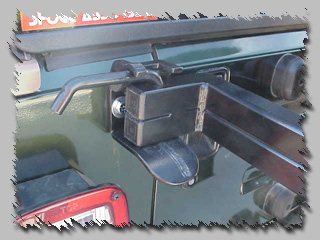
Here is the rack latch shown in the closed position. The handle is spring loaded. You can bend the “keeper” which the handle slips under in order to keep things from rattling around. A 10″ vice grip worked good for this adjustment. The latch and striker plate seem to really lock up tight. I hope they are this good after a few years of bouncing down the trail.
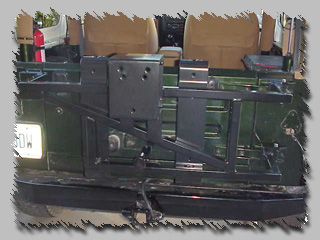
The mounted rack, before the tire studs have been installed. You can see the large flat plate with the 5 holes drilled into it. The 4.5″ pattern uses the lower pair and the 5.5″ pattern uses the upper pair of holes. Hopefully yours won’t need adjusting.
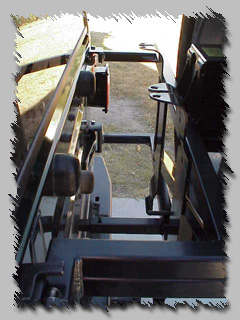
You can get an idea of the space between the body and the rack itself. I set a jerry can in place and gently closed the door. Those rubber bumpers from the old tire carrier setup makes for a really tight squeeze. They will go in a day or two which will allow sufficient space for the jerry cans.
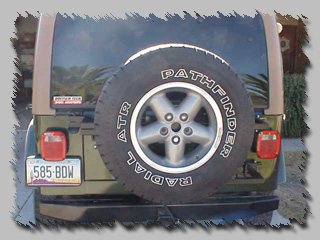
A shot from the rear after the tire has been mounted. There seems to be enough room on the rack for a Hi-Lift jack to be installed. I think I can work out something that will hold the jack firmly in place and not be in the way of the cans.
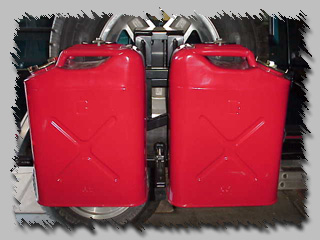
These last two pictures were taken a few days after I got the rack mounted. I stopped by the 4 wheeler’s supply shop and picked up a couple of new cans. My old one was from the mid ’70s and was looking pretty bad inside. Here is a good view of how everything comes together once it is mounted and bolted down tight. As you can see, there is nothing left hanging on the TJ’s tail gate any longer. The cans and spare tire are all supported by the new rack.
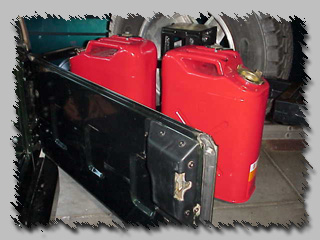
Here is a straight on shot of both cans mounted on the rack. 10 gallons will increase the range of the TJ another 50%, which makes multi-day trips a reality.
Update December 19, 1999
I racked up (no pun intended) my first 100 miles last week during a two day trip. These miles were all off-highway miles, with a quite a few hours spent in 4LO range. The rack held up well. The latch stayed nice and tight and did not rattle. One thing I noticed (and I am working on solution now) was that the TJ sits lower on the suspension. Just before this trip, I had installed a new Tomken gas tank skid plate. Between the new skid, the new rack, two cans of gas, and some camping equipment, she was down some in clearance in the rear. Like they say, everything is a compromise. However, having the extra 10 gallons will be a life saver. I ran the last 36 miles of the trip (before gassing up at a station) with the gas gauge sitting on EMPTY (it was 10:30 PM and I didn’t want to transfer gas if I didn’t have to). I would have been sweating bullets had I not had the extra gas along. I am certain I would not have made it back to my home without gassing up.
Update July, 2000
It has been about 7 months since the rack was mounted and I still love it. No rattles, no problems….it just keeps on going. I contacted Tera about the sagging rear end and they suggested I install a set of their coil spacers. They have a set made for my lift, and they recommend using them on the front springs, after installing a heavy winch, and/or adding them to the rear after doing a project like mine. It did the trick, and everything is back to being nice and level again. I finally found an obstacle that put the rack to the test, Widow Maker on the Metal Masher trail at Moab, UT. The rack held up fine. I get quite a few nice comments from guys on the trail about the rack. They like the height and reinforced hinge backing plates that makes for such a solid mount.
